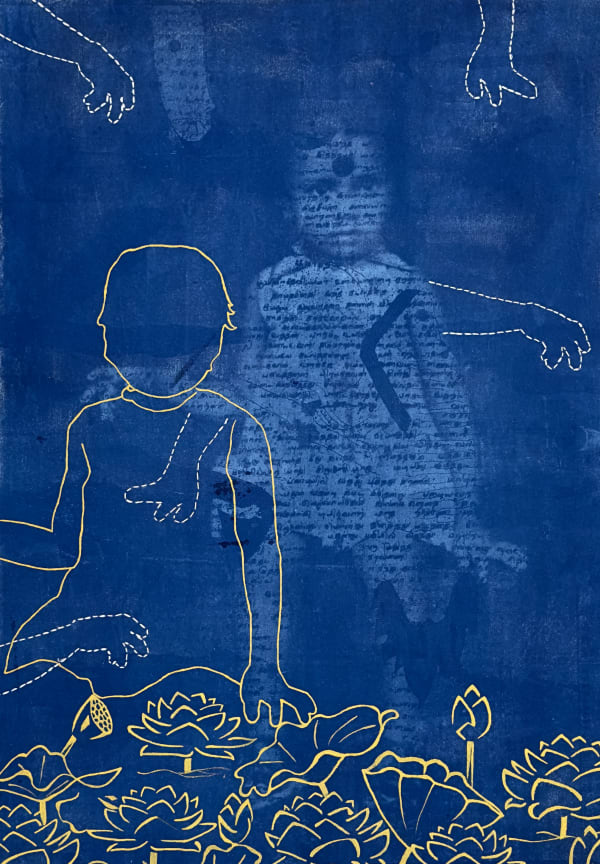-
-
Wading through the certainty of impermanence, Arra Kuļamum, Kottiyum, Āmpalum seeks to revisit family archives not as mere static records, but as embodiments of tender longing. Haunting apparitions of landscapes and family photographs—strewn with blooming lotuses and resonant with the cadence of ritual hymns—become necessary shelter in Ram’s cyanotypes and sculptures. These elements act as emotional and spiritual anchors, constructing a space of imagined return. Yet, even as the imagery invites rumination, they are underscored by a persistent sense of unmooring. The artist imbues each artwork with the hushed ache of impermanence - the painful resignation that belonging itself may be illusory as the possibility of absence in the future looms over.
-
-
-
-
Inscribed onto the surface of his cyanotypes are the words from the Vaikuntha Ammanai—a chant recited in Tamil-speaking Hindu communities of Batticaloa for thirty-one days following a death. Historically and culturally rooted in the cyclical and repetitive nature of life, this hymn becomes a framework through which the artist reconciles with existential angst and grief. Though traditionally associated with a period of mourning from which return is grievous, the chant transforms into an antidote—soothing in its rhythm
-
Binding lived experiences of grief and transition to mythological narratives drawn from the Mahabharata, the work threads the personal with the divine, allowing the impermanent to be ritualized, acknowledged, and, ultimately, endured. Layered with fragments of text, embroidery, and photographic imprints, Ram’s cyanotypes function as visual palimpsests—bridging temporalities and realms.
-
-
Arra Kuļamum, Kottiyum, Āmpalum draws its title from a Tamil verse attributed to the poetess Avvaiyar, in which the inhabitants remaining within a dried pond becomes a powerful metaphor for absence and endurance. In the verse, birds — once lured by the pond’s waters — retreat as it dries. Yet amid the parched earth, certain aquatic plants such as Koṭṭi, Āmpal, and Neythal remain, their stems sunk deep into the desiccated soil. These enduring species, clinging to life in the absence of sustenance, speak to a form of resilience — one that persists in stillness, remembrance, and in the aftermath of abandonment.
-
-

-
-

The installation Veḷḷat Taṉaiya Malar Nīṭṭam unfolds as a descending pondscape—an undulating furl of fabric that gently pools at the base. From its depths rise delicate lotuses and floating pads, each crafted from paper, emerging out of the surface of the water with resilience. The image of Ram’s father, bicycle in hand, appears on the fabric in quiet tribute.
-
The title, Veḷḷat Taṉaiya Malar Nīṭṭam, draws from the ancient Tamil poetic tradition of Purananuru. In its literal sense, it refers to the graceful stretch of a lotus rising through floodwaters. But in its deeper, metaphorical resonance, it describes a person whose virtues—like the lotus—rise with dignity and expansiveness even amid adversity. It is a tribute to quiet strength, to generosity that meets hardship not with retreat but with a bloom.
-
Lojithan Ram's practice, rooted in archival explorations and textual analysis, emerges from an intimate confrontation with estrangment—both lived and inherited. Rather than finding anchor solely in his own story and familial experiences, he turns toward the broader, collective narrative of dislocation and rootlessness experienced by his community in the Eastern Province of Sri Lanka, finding echoes of his own experience in shared silences and spectral absences.
-
-
Arra Kuļamum, Kottiyum, Āmpalum notes the ways in which possession exists in a tenuous hold within the artist’s personal history and community. Memories, families, and places —are revealed to be transient, elusive, and subject to erasure. In this nebulous state, Ram does not seek resolution; instead, he inhabits the in-between space where belonging dissolves and reforms in shifting configurations. Where possession and certainty are rendered null and void, replaced instead by a quiet, persistent ache—and a profound tenderness—that resides in the act of remembering itself.
AṞṞA KUḶAMUM, KOṬṬIYUM, ĀMPALUM: Lojithan Ram
Past viewing_room




























